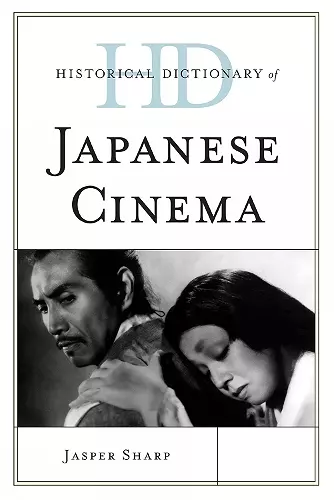Historical Dictionary of Japanese Cinema
Format:Hardback
Publisher:Scarecrow Press
Published:13th Oct '11
Currently unavailable, and unfortunately no date known when it will be back

The cinema of Japan predates that of Russia, China, and India, and it has been able to sustain itself without outside assistance for over a century. Japanese cinema's long history of production and considerable output has seen films made in a variety of genres, including melodramas, romances, gangster movies, samurai movies, musicals, horror films, and monster films. It has also produced some of the most famous names in the history of cinema: Akira Kurosawa, Hayao Miyazaki, Beat Takeshi, Toshirô Mifune, Godzilla, The Ring, Akira, Rashomon, and Seven Samurai. The Historical Dictionary of Japanese Cinema is an introduction to and overview of the long history of Japanese cinema. It aims to provide an entry point for those with little or no familiarity with the subject, while it is organized so that scholars in the field will also be able to use it to find specific information. This is done through a detailed chronology, an introductory essay, and appendixes of films, film studios, directors, and performers. The cross-referenced dictionary entries cover key films, genres, studios, directors, performers, and other individuals. This book is an excellent access point for students, researchers, and anyone wanting to know more about Japanese cinema.
Japanese film authority Sharp (Behind the Pink Curtain: The Complete History of Japanese Sex Cinema) opens this landmark reference with an extensive chronology, noting the political and economic events that facilitated the development and expansion of Japan’s film culture. The bulk of the book defines Japanese cinema’s principal studios, directors, actors, film techniques, historical periods, genres, and major films. Multiparagraph entries are alphabetized by the English-translated Japanese words, followed by both Hepburn Romanization and traditional kanji characters. A nearly 100-page, by-theme bibliography is a treasure trove of research leads. To date, the most comprehensive English guide; its depth and breadth make it vital for film-studies collections. * Library Journal *
Though dominated by major studios with their own style and audience, by 2008 with 418 domestic films Japan was one of the world’s largest film-producing countries. That makes this new reference source by Sharp, one of the world’s leading experts on Japanese cinema, especially valuable. A chronology and introduction are followed by extensive entries on directors, actors, major studios, cinematic genres, significant historical periods, and outstanding films. * Library Journal (Reference) *
Japanese cinema has an illustrious history. This historical dictionary of Japanese cinema strives to give the reader a grasp of that history. This valuable reference work opens with a chronology beginning with 1450 B.C.E. and ending with 2010. This chronology is followed by an introduction that discusses the evolution of Japanese cinema, the state of the industry, and the various genres heavily represented in Japan's cinema (e.g., melodramas, romances, samurai movies, horror films, and monster films). The heavily cross-referenced historical dictionary deals with people, cities, movements, genres, groups, movies, and critical topics. Film names are given in English followed by their Japanese title translations, information about authorship, and date of premier. The body of the film entries deals with historical background of the work. Entries for individuals include name, vital dates, occupation, and a historical perspective essay. There is an extensive bibliography organized around several main themes: film history film theory and criticism, animation, festivals, war and film, women filmmakers, and ethnicity and racial identity. Scholars as well as casual readers can certainly learn a great deal about one of the foundations of eastern culture. * American Reference Books Annual *
This large single volume will particularly assist by providing information on lesser known directors, actors, and other film personnel; studios; and typical Japanese genres....This is an extremely interesting, readable and worthy work of the type that one feels is a labor of love from a writer and curator specializing in Japanese cinema, and who is thoroughly knowledgeable on his subject. * s *
- Winner of Library Journal Best Reference Book for 2011 2011
ISBN: 9780810857957
Dimensions: 238mm x 163mm x 43mm
Weight: 957g
564 pages